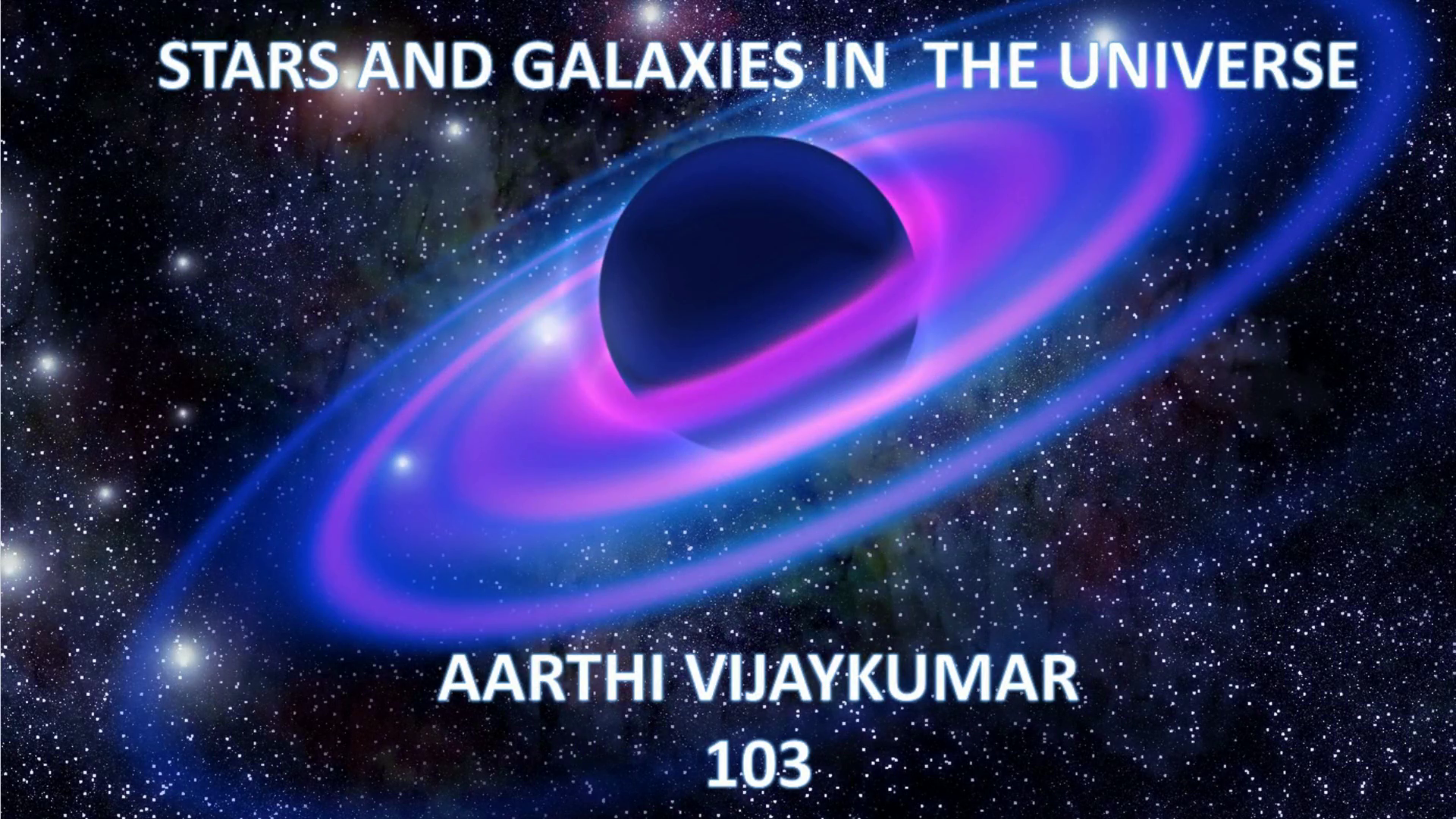Scene 1 (0s)
STARS AND GALAXIES IN THE UNIVERSE AARTHI VIJAYKUMAR 103.
Scene 2 (9s)
ANALIZING STARLIGHT All stars have dark-line spectra. A stars dark-line spectrum reveals the stars composition and temperature. Stars are made up of different elements in the form of gases. Scientists can determine the elements that make up a star by studying its spectrum. The Compositions of Stars Scientists have learned that stars are made up of the same elements that compose Earth. The most common element in stars is hydrogen. Helium is the second most common element in star. Small quantities of carbon, oxygen, and nitrogen are also found in stars. The Temperatures of Stars The temperature of most stars ranges from 2,800C to 24,000C. Blue stars have average surface temperatures of 35,000C. Yellow stars, such as the sun, have surface temperatures of between 5,000C and 6,000C. Red stars have average surface temperatures of 3,000C..
Scene 3 (1m 27s)
Distances to Stars Distances between the stars and Earth are measured in light-years. Light-year the distance that light travels in one year. About 9.5 trillion kilometers (5.8 trillion miles). THE LIFE CYCLE OF STARS.
Scene 4 (1m 49s)
PILLARS OF CREATION THE 'PILLARS OF CREATION' ARE NAMED AFTER A PHOTOGRAPH TAKEN BY THE HUBBLE SPACE TELESCOPE. THEY ARE FORMATIONS OF COOL INTERSTELLAR GAS ( MOLECULAR HYDROGEN ) AND DUST. THEY ARE LOCATED I SPACE NEAR THE EAGLE NEBULA ( ALSO KNOWN AS THE STAR QUEEN NEBULA ) AND THE SPIRE, SOME 7,000 LIGHT YEARS FROM THE EARTH..
Scene 5 (2m 17s)
BLACK HOLES WHEN A STAR RUNS OUT OF FUEL, IT MAY COLLAPSE. FOR SMALLER STARS, THE NEW CORE WILL BE A NEUTRON STAR OR A WHITE DWARF. BUT WHEN A LARGER STAR COLLAPESES, IT COUNTINUES TO FALL IN ON ITSELF TO CREATE A BLACK HOLE. BLACK HOLES ARE SOME OF THE STRANGEST AND MOST AMAZING OBJECTS IN OUTER SPACE. THEY ARE SPECIFIC REGIONS OF SPACETIME WHERE GRAVITY PULLS SO STRONGLY THAT EVEN LIGHT CANNOT ESCAPE. THE FIRST ONE DISCOVERED IN 1971, BUT THE TERM 'BLACK HOLE' HAD ALREADY BEEN COINED IN 1967 BY AMERICAN ASTRONOMER JOHN WHEELER. HE BASED HIS EXPLORATION ON ALBERT EINSTEIN'S GENERAL THEORY OF RELATIVITY, IN WHICH THE GREAT SCIENTIST PREDICTED THE EXISTENCE OF BLACK HOLES IN 1916. THERE ARE THREE TYPES: STELLAR BLACK HOLES, SUPERMASSIVE BLACK HOLES AND INTERMIDIATE BLACK HOLES..
Scene 6 (3m 18s)
Galaxies Galaxies are the major building blocks of the universe. Astronomers estimate that the universe contains hundreds of billions of galaxies. A typical galaxy, such as the Milky Way, has a diameter of about 100,000 light-years and may contain more than 200 billion stars. Types of Galaxies Galaxies are classified by shape into three main types. A spiral galaxy has a nucleus of bright stars and flattened arms that spiral around the nucleus. Elliptical galaxies have various shapes and are extremely bright in the center and do not have spiral arms. An irregular galaxy has no particular shape, and is fairly rich in dust and gas..
Scene 7 (3m 54s)
SPIRAL GALAXY Spiral galaxies are typically disk-shaped with a somewhat greater concentration of stars near their centers, often containing arms of stars extending from their central nucleus. (30 of all galaxies) ELLIPTICAL GALAXY Elliptical galaxies are the most abundant type, 60 of all galaxies, which have an ellipsoidal shape that ranges to nearly spherical, and lackspiral arms. IRREGULAR GALAXY Irregular galaxies, which lack symmetry and account for only 10 of the known galaxies. BARRED SPIRAL A barred spiral galaxy is a spiral galaxy with a central bar-shaped structure made of stars.
Scene 8 (4m 51s)
THE MILKY WAY The Milky Way Galaxy is a large, disk-shaped, spiral galaxy about 100,000 light-years wide and about 10,000 light-years thick at the center. There are three distinct spiral arms of stars, with some showing splintering. The Sun is positioned in one of these arms about two-thirds of the way from the galactic center, at a distance of about 30,000 light-years. MOST LARGE GALAXIES HAVE A SUPERMASSIVE BLACK HOLE AT THE CENTRE, AND THE MILKY WAY IS NO EXCEPTION. THE CENTRE OF R GALAXY IS CALLED SAGITTARIUS A* OR SAG A*.
Scene 9 (5m 41s)
THE UNIVERSE The Universe contains billions of galaxies with each galaxy containing billions of stars. Universe is always evolving. Everything that exits in the universe is not permenant. New stars are being born while existing stars will eventually die. The universe is space and all matter and energy in it. A Poem For The Universe Up the sky I share I look up and wish I’m there, Beautiful and rare.
Scene 10 (6m 15s)
YOU!.
